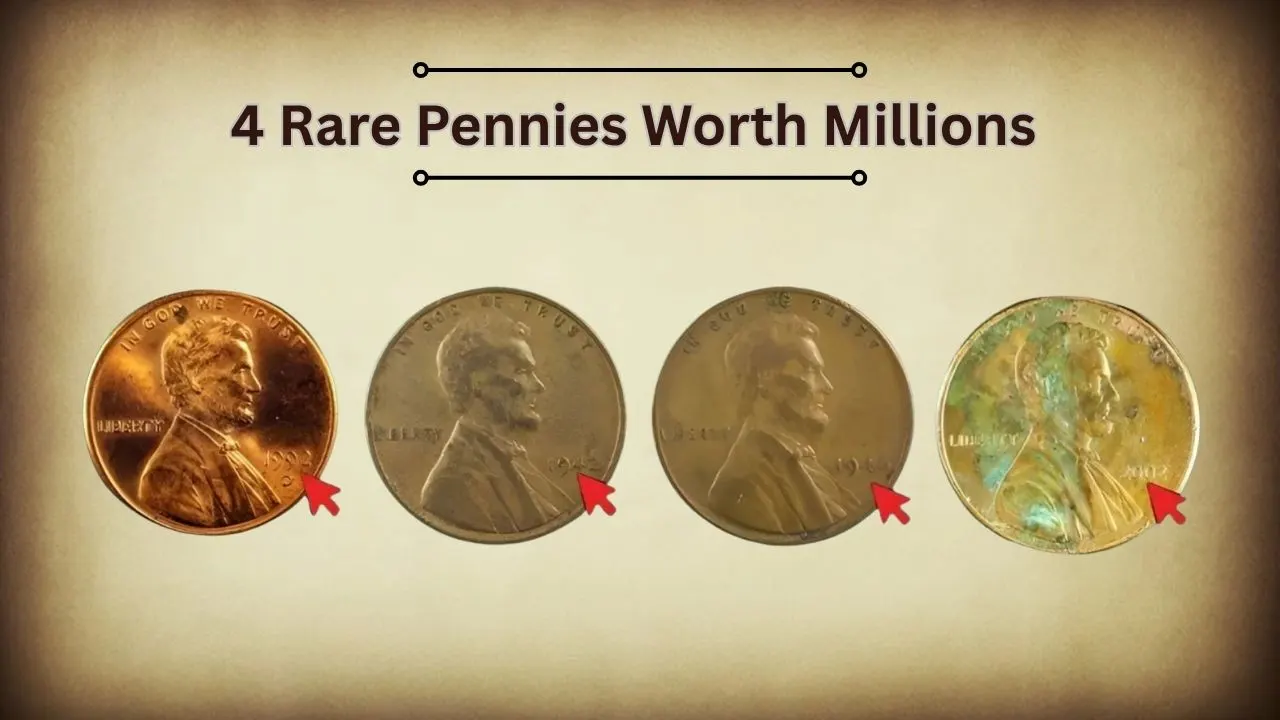Imagine getting a penny in your change and finding out it’s worth millions. It sounds unbelievable, but some rare Lincoln Wheat pennies from past decades can fetch eye-popping prices due to minting errors or unique characteristics. Whether you’re a seasoned collector or just someone who enjoys browsing through spare change, this article will guide you through four rare pennies worth millions that could still be out there, waiting to be discovered in your collection.
What Makes These Pennies So Valuable?
The key to a penny’s value lies in its rarity, error, and sometimes its composition. While most pennies are worth just a cent, specific varieties of the Lincoln Wheat Penny can be worth hundreds of thousands, even millions, of dollars. These extraordinary coins were created due to minting mistakes or were made using the wrong materials, making them sought after by collectors. Condition is also vital – well-preserved coins command higher prices.
A Glimpse Into Penny History
The Lincoln Wheat Penny was first introduced in 1909, celebrating the 100th birthday of President Abraham Lincoln. Over the years, the coin has gone through various changes in its composition, with most pennies being produced with copper and later with a zinc coating. Wartime shortages, minting errors, and unique metal mixes have all played a role in the creation of rare, valuable pennies still in circulation today.
The 4 Rare Pennies You Should Be Looking For
1. 1943 Bronze Lincoln Cent
During World War II, copper was needed for ammunition, so the U.S. Mint produced pennies using zinc-coated steel. However, a small number of pennies were accidentally struck on leftover copper blanks from 1942. These 1943 bronze pennies are incredibly rare and can fetch up to $1.7 million at auction.
- How to Spot It:
- It should be copper in color (not steel gray).
- Test with a magnet: If the coin sticks, it’s steel. If it doesn’t, it’s likely copper.
- Weight: Copper pennies weigh about 3.11 grams, while steel ones weigh around 2.7 grams.
- Value: Up to $1.7 million.
2. 1944 Steel Wheat Penny
After switching to copper in 1944, some leftover steel planchets from 1943 were used to strike pennies. These 1944 steel pennies are just as rare as the 1943 bronze penny and can be worth anywhere from $100,000 to $200,000.
- How to Spot It:
- Appearance: The coin will have a steel appearance, not the usual copper look.
- Weight: Steel pennies weigh about 2.7 grams.
- Value: Between $100,000 and $200,000.
3. 1955 Doubled Die Penny
One of the most famous minting errors, the 1955 doubled die penny, features doubling on the word “LIBERTY” and the date “1955”. This doubled die error happened when the die used to stamp the coin was misaligned, causing a double impression.
- How to Spot It:
- Look for doubling in the letters and numbers on “LIBERTY” and “IN GOD WE TRUST”.
- Magnifying glass will help spot the doubling clearly.
- Value: Ranges from $1,000 to $50,000+ depending on condition.
4. 1969-S Doubled Die Lincoln Cent
The 1969-S doubled die penny is another doubled die error, but it is often confused with fakes. Authentic versions, featuring double images on the date and inscriptions, are highly sought after by collectors, fetching prices as high as $75,000 or more.
- How to Spot It:
- Look for dramatic doubling on the date (1969) and inscriptions on the front.
- A magnifying glass or microscope will reveal this doubling clearly.
- Value: Up to $75,000+ for authentic examples.

Comparison of Rare Million-Dollar Pennies
| Penny Type | Year | Error Type | Metal Composition | Estimated Value |
|---|---|---|---|---|
| Bronze Lincoln Cent | 1943 | Wrong planchet | Bronze (Copper) | $100,000 – $1.7 million |
| Steel Wheat Penny | 1944 | Wrong planchet | Steel | $100,000 – $200,000 |
| Doubled Die Penny | 1955 | Die doubling | Copper | $1,000 – $50,000+ |
| Doubled Die Penny | 1969 | Die doubling | Copper | $25,000 – $75,000+ |
Quick Identification Tips
It’s essential to know how to properly examine a coin to identify these rare finds. Here’s a quick checklist to help you spot a potential gem:
| Feature | What to Check | Significance |
|---|---|---|
| Magnet Test | Sticks = Steel, Doesn’t = Copper | Helps identify the 1943 bronze penny |
| Date Doubling | Visible on “LIBERTY” & “DATE” | Indicates doubled die error |
| Weight Test | Copper = 3.11g, Steel = 2.7g | Confirms metal composition |
| Mintmark | Look for “S” or “D” below date | May indicate limited mint issue |
Expert Tips for Coin Hunters
- Check every penny you get in change — even modern ones.
- Use a magnifying glass or coin microscope to spot doubling or misprints.
- Never clean a coin — it can destroy its collector value.
- Get coins verified by PCGS or NGC for authentication and grading.
- Store coins safely in albums or storage cases to preserve their value.
Conclusion
These four rare pennies worth millions remind us that treasures can appear in the most ordinary places. The next time you get change from a store, look twice — that dull copper coin might just be your ticket to a small fortune. The thrill of discovery is what keeps collectors searching, and who knows? The next rare penny might be in your pocket right now.
FAQs
Yes, although extremely rare, a few have surfaced in recent years. Keep an eye out for rolls or old jars.
Look for doubling, off-color metal, or the wrong year/metal combination.
Certified auction houses, coin dealers, or online platforms like Heritage Auctions are best.